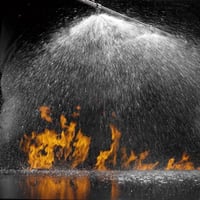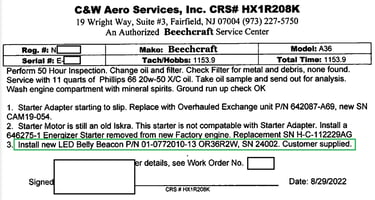Present your aircraft to potential buyers like never before...
Debunking Safe Logbook Handling Myths

Just because your old paper records are still around does not mean they are legible!
We've met with many owners throughout the country and have heard lots of reasons why they think their logbooks are safe. Some have good reasons and actually do what they should to safely backup their logbooks, and others are tricked by the myths spread throughout the industry.
Myth 1: A safe is all you need.
First, many people have mentioned using a gun safe, and some have mentioned scanning and backing up in the cloud. The gun safe is a good idea and one we use for logs in the receiving line, waiting to be professionally scanned in our office. However, you should not rely on a safe to keep your logs protected. Gun safes are fire rated generally (at least ours is, and we strategically position our office within .1 miles of the local fire department), but that doesn't mean fire proof or water proof. Further, it does not solve the problem of Myth 3 down below.
We devised a system that uses a gun safe until the logs are ready to be scanned. We then use the highest quality scanners we can get to take very high resolution images. These images are processed and stored redundantly. This step is important. One copy in Dropbox/Google drive is certainly good, but not great. We store over 6 copies across many hard drives and diversify our media storage to compensate for the pros and cons of different technologies (i.e. HDD vs SSD). We also use RAID storage to provide fault tolerance, separate drives to provide true backups, and finally off site storage that is duplicated in another US State to hedge geographical risk.
Simply put, your logbooks are usually the most valuable part on your airplane. Yet so few people treat them with the care they deserve.
Myth 2: Just keep them in the plane.
We've heard from many people that they just keep them in the airplane so that way they have them and if they go down in a crash, it doesn't matter anymore. This is a big problem because if you crash and your logs are destroyed, the insurance company may not pay out, meaning your family/loved ones may not get the money they deserve after you're gone or seriously injured. Also, if you've heard the saying "In an emergency it's not your airplane, it's the insurance company's," this may not be so true if your logbooks are destroyed in the crash since you may not get your insurance money.
Myth 3: As long as they leave my possession for annual only it's fine.
Your logs should not be leaving your possession, ever, until after you sell the plane. Even at an annual because that is when they are most vulnerable. This is not to say maintenance shops are careless, but they are busy! It's just too easy for them to be left out when closing time comes or for oil, water, etc to be dumped on them. We've heard loads of horror stories, including one shop holding the logs as collateral until the owner paid for an unexpectedly high annual.
Myth 4: Your plane can still legally fly if the logs are lost/permanently destroyed.
Without your logs you cannot prove compliance with the FARs (91.207 ELT, 91.411 and 91.413 Alt/Trans and Static checks, for example) or ADs applicable to your aircraft, which simply put means you are not airworthy. Without the proof, it doesn't matter if you know the plane has complied with all the inspections because that plane cannot legally fly. You will need to get the inspections done over, and if the plane needs to fly to a shop to have them done you will need a ferry permit. Either way, you are likely looking at thousands of dollars to make the plane airworthy again.
Conclusion: Whether you use a professional and reliable service like ours, or devise a system for yourself, just keep in mind that those logs are valuable for many reasons and recreating them can be quite expensive and time consuming.
Fly safe!



